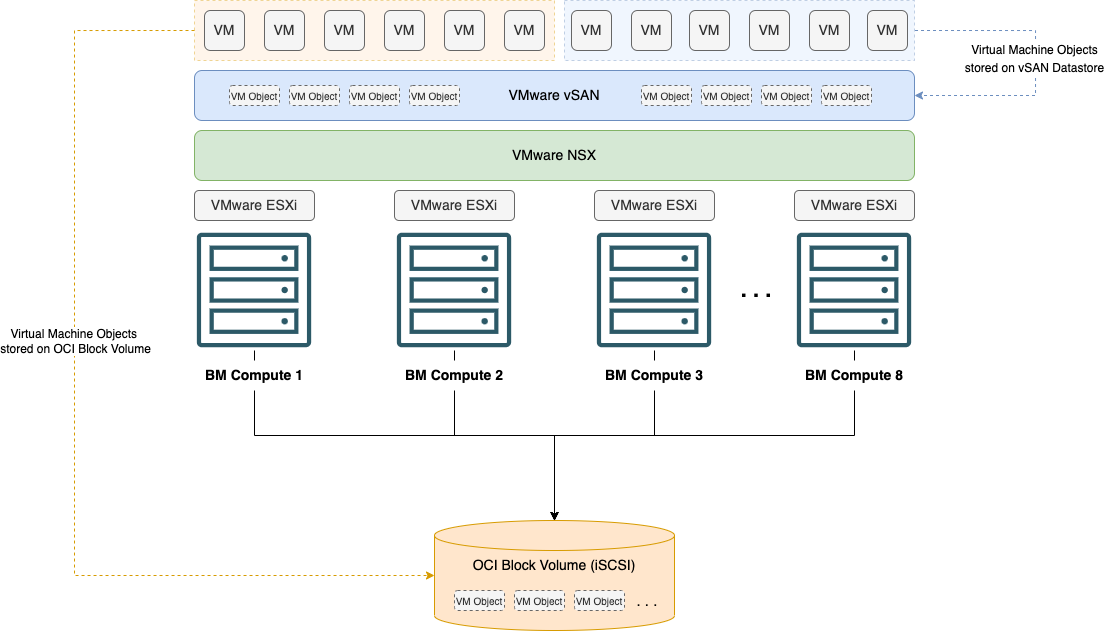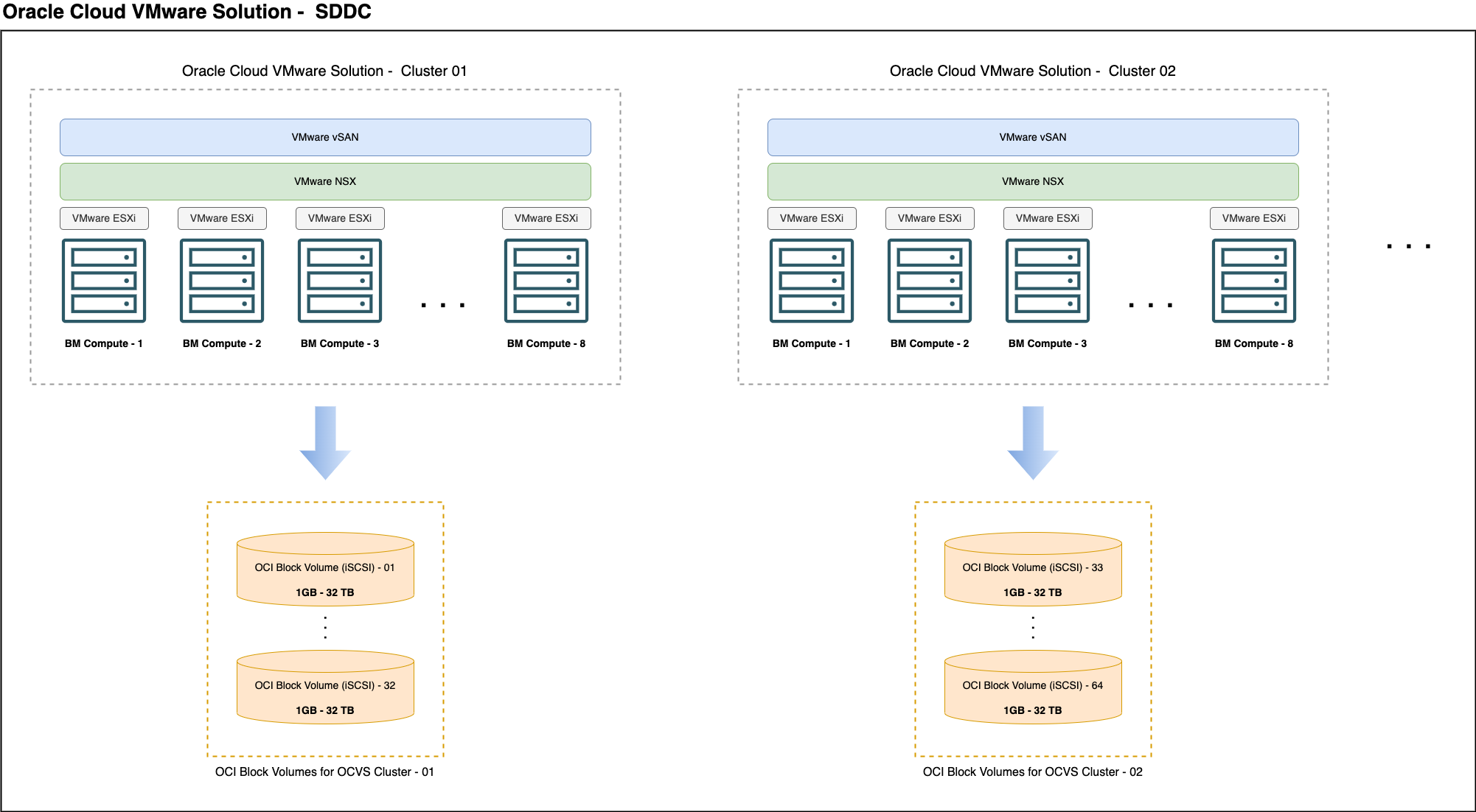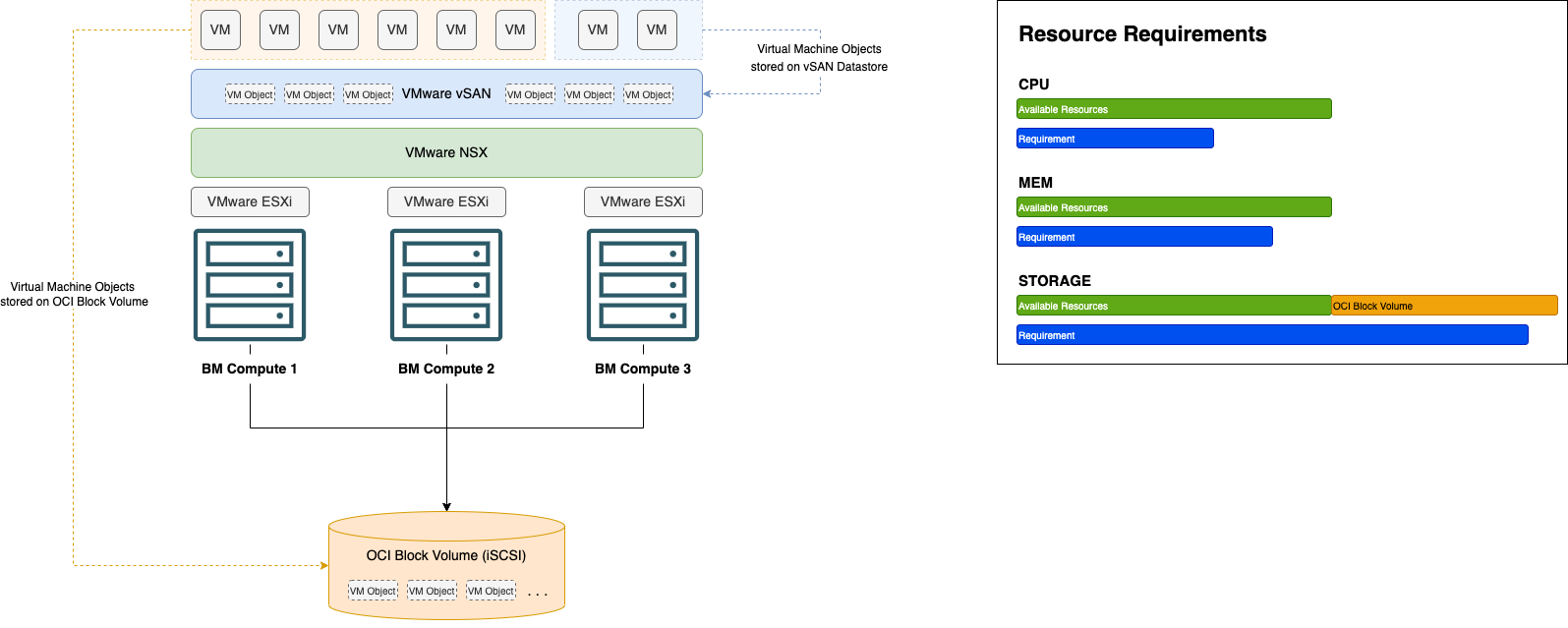When it comes to storage options for Oracle Cloud VMware Solution, customers were previously limited to the primary storage option, VMware vSAN datastore, or Oracle Cloud Infrastructure (OCI) File Storage service as a secondary storage option. With the announced general availability of OCI block volumes for Oracle Cloud VMware Solution, a new option for scaling Oracle Cloud VMware Solution clusters’ storage capacity is now available.
The latest storage technology that is now available with Oracle Cloud VMware Solution is the OCI Block Volume service, which provides highly redundant and high-performance storage at a low cost. You can create OCI block volumes as internet small computer system interface (iSCSI) block volumes, attach them to the Oracle Cloud VMware Solution hosts, and use them as an iSCSI datastore to host virtual machines (VMs), store templates, ISOs, and so on. With features such as performance autotuning, automated backup and disaster recovery, and block storage cloning, you have access to high-performance, low-cost block storage for their VMware workloads on OCI.
OCI Block Volume lets you dynamically provision and manage block storage volumes. You can create, attach, connect, and move volumes and change volume performance as needed to meet your storage, performance, and application requirements. Volumes are only accessible to instances in the same availability domain.
Oracle Cloud VMware Solution with OCI block volumes
With OCI block volumes attached to an Oracle Cloud VMware Solution cluster, you now have the option to build a hybrid storage scenario with VMware vSAN and OCI block volumes to scale out your existing Oracle Cloud VMware Solution clusters on the storage level without needing to deploy another bare metal host.

How Oracle Cloud VMware Solution scales with OCI block volumes
Oracle Cloud VMware Solution clusters with OCI block volumes attached can scale to a maximum of eight bare metal hosts, which is the attachment limit for a single OCI block volume. This expansion results in a total of eight Oracle Cloud VMware Solution clusters per software-defined data center (SDDC) with eight hosts per cluster and 32 block volumes per Oracle Cloud VMware Solution cluster.
A single block volume can have a maximum size of 32 TB, which allows an eight-node Oracle Cloud VMware Solution cluster with 32 block volumes attached to provide up to 1 PB of storage capacity for VMs, minus 10–20% capacity reserve per OCI Block Volume.
You can’t share OCI block volumes across Oracle Cloud VMware Solution clusters. OCI block volumes are always dedicated to the bare metal hosts running in an Oracle Cloud VMware Solution cluster.

OCI Block Volume attachments to Oracle Cloud VMware Solution clusters
The following table demonstrates how you can attach OCI block volumes to clusters within an Oracle Cloud VMware Solution clusters SDDC. The block volumes aren’t shared across clusters because each cluster has a dedicated set of OCI block volumes attached with the maximum capacity of 1,024 TB (32 x 32 TB).
| SDDC |
Cluster |
ESXi Host |
OCI Block Volumes |
Size |
Cluster Storage |
| OCVS-SDDC-01 |
OCVS-SDDC-01-Cluster-01 |
ESXi-01 – ESXi-08 |
Block-Volume-01 – Block-Volume-32 |
32 TB |
1,024 TB |
| OCVS-SDDC-01 |
OCVS-SDDC-01-Cluster-02 |
ESXi-09 – ESXi-16 |
Block-Volume-33 – Block-Volume-64 |
32 TB |
1,024 TB |
| OCVS-SDDC-01 |
OCVS-SDDC-01-Cluster-03 |
ESXi-17 – ESXi-24 |
Block-Volume-65 – Block-Volume-96 |
32 TB |
1,024 TB |
| OCVS-SDDC-01 |
OCVS-SDDC-01-Cluster-04 |
ESXi-25 – ESXi-32 |
Block-Volume-97 – Block-Volume-128 |
32 TB |
1,024 TB |
| OCVS-SDDC-01 |
OCVS-SDDC-01-Cluster-05 |
ESXi-33 – ESXi-40 |
Block-Volume129 – Block-Volume-160 |
32 TB |
1,024 TB |
| OCVS-SDDC-01 |
OCVS-SDDC-01-Cluster-06 |
ESXi-41 – ESXi-48 |
Block-Volume161 – Block-Volume-192 |
32 TB |
1,024 TB |
| OCVS-SDDC-01 |
OCVS-SDDC-01-Cluster-07 |
ESXi-49 – ESXi-56 |
Block-Volume162 – Block-Volume-224 |
32 TB |
1,024 TB |
| OCVS-SDDC-01 |
OCVS-SDDC-01-Cluster-08 |
ESXi-57 – ESXi-64 |
Block-Volume225 – Block-Volume-256 |
32 TB |
1,024 TB |
Use case for OCI block volumes with Oracle Cloud VMware Solution
A basic use case for integrating OCI block volumes with Oracle Cloud VMware Solution includes applications with heavy storage demands from data growth and CPU and memory resources not scaling linearly with that storage demand. The Oracle Cloud VMware Solution cluster with vSAN as the standard storage can’t satisfy the storage demand of the applications running on Oracle Cloud VMware Solution because of the heavy demand for storage growth.

The Oracle Cloud VMware Solution cluster with vSAN as the standard storage can’t satisfy the storage demand of the applications running on Oracle Cloud VMware Solution because of the heavy demand for storage growth. To accommodate the growing storage demand, we attach OCI block volumes to satisfy to growing storage demand.

As a result, we can scale the storage independently without the need to deploy more Oracle Cloud VMware Solution bare metal hosts. This method brings the advantage that no CPU and memory resources are wasted, and no extra guest operating system licenses are required, which decreased the overall cost of the environment.
Want to know more?
For more information on the concepts in this blog post and solutions from Oracle Cloud Infrastructure, see the following resources:

